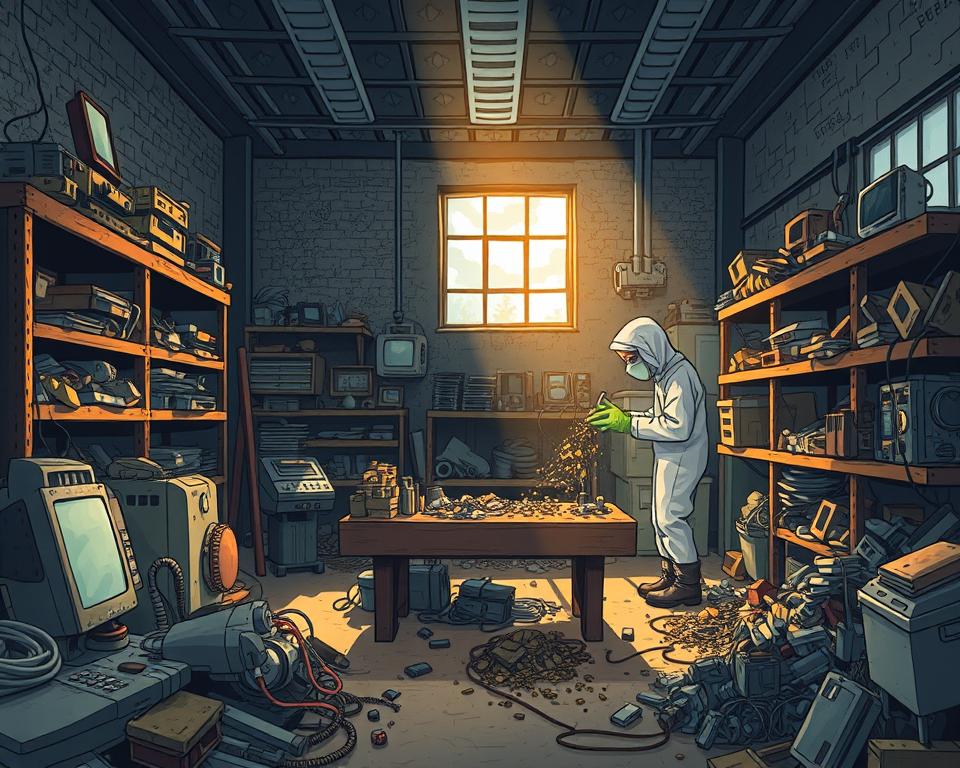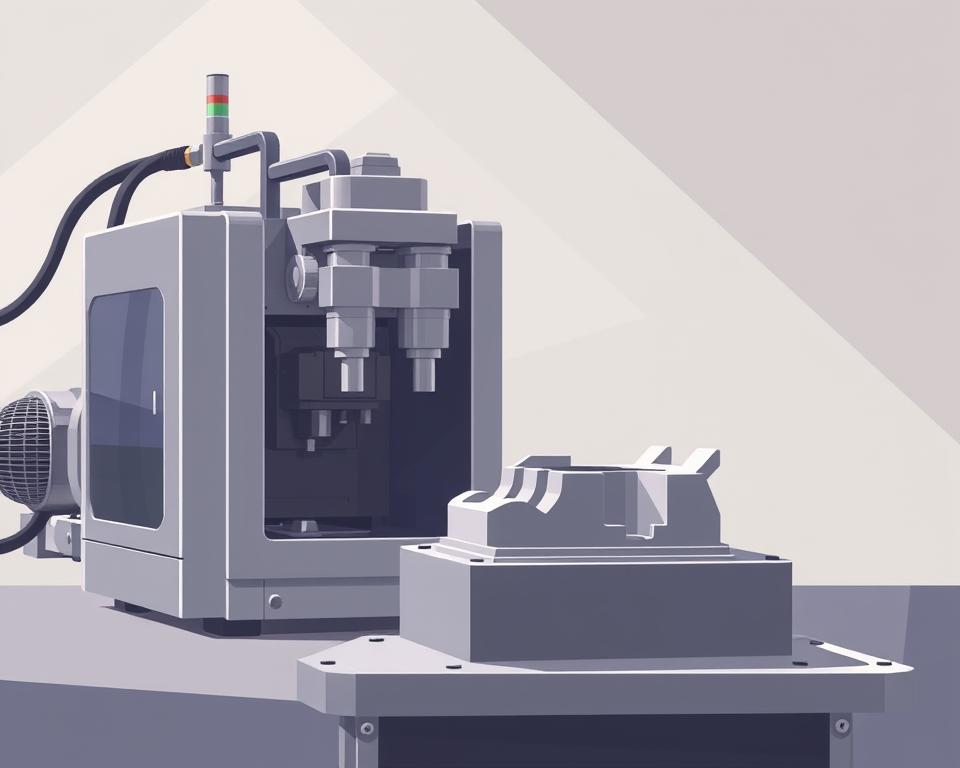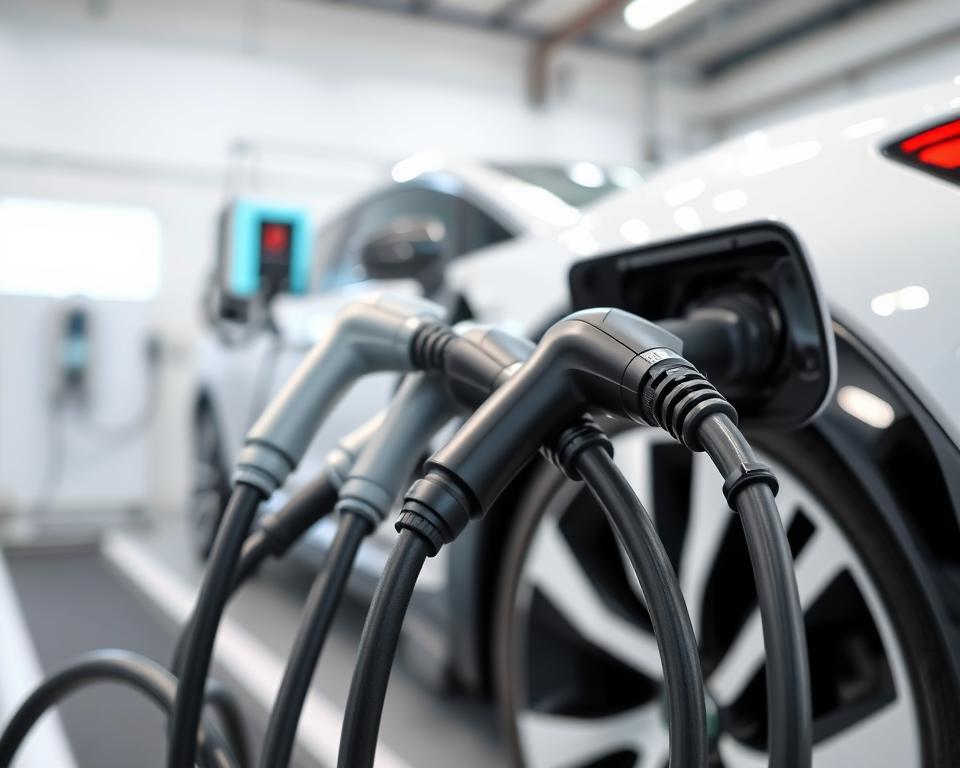Comprehensive Guide to Eco-Friendly Precious Metal Recovery
More than $60 billion in precious metals end up in e-waste every year—did you realize that? Such a massive amount highlights why precious metal recycling is so vital. It’s not just good for our economy but also for the environment. Reclaiming gold, silver, platinum, and palladium helps lower pollution and preserve what’s left of our natural resources.
Leaders such as Dongsheng Metal Trading are paving the way for sustainable recycling. They ensure these valuable metals are reused, not dumped in landfills. Such a precious metals recycling model drives eco-friendly recycling and sustainable methods.
Key Insights
- Over $60 billion in precious metals is disposed of in electronic waste annually.
- Recovering these metals cuts eco-impact and preserves resources.
- Key precious metals are gold, silver, platinum, and palladium.
- Sustainable development depends on eco-friendly recycling.
- Recycling experts like Dongsheng Metal Trading lead the industry.
Understanding Precious Metals and Their Value
Rare metallic elements known as precious metals attract both investors and manufacturers. Examples include gold, silver, platinum, and palladium, each prized for special traits. Notable traits are excellent conductivity, corrosion resistance, and rarity. Extracting and refining them uses up huge resources, so recycling becomes critical.

The value of precious metals is influenced by market demand and the inherent qualities of each metal. Recovering metals is key to keeping the supply chain alive. It lowers the ecological damage from mining. Advanced recycling can bring metals back to their initial quality. Such efforts save limited resources and create economic gains.
Defining Precious Metals
Unique features make precious metals ideal for many uses. Economic value stems from their scarcity and innate qualities. For example:
- Gold: Admired for its luster and low corrosion.
- Silver: Celebrated for its adaptability and conductivity.
- Platinum: Esteemed for its toughness and catalyst role.
- Pd: On the rise in automotive and tech industries.
Why Recycle Precious Metals?
Recycling these metals is now key to sustainable practices. It preserves resources and lessens the environmental cost of mining. Consider these advantages:
- Lessening of habitat destruction from mining.
- Using far less energy than fresh extraction.
- Contribution to a circular economy by reintroducing materials into production cycles.
- Economic upside from extracting high-value resources.
Impact of Recycling Precious Metals
Recycling precious metals offers substantial environmental and economic benefits. Emphasizing benefits helps cut environmental harm. Additionally, it fuels market growth and resilience.
Environmental Benefits
Recycling metals yields major environmental perks. When we recover metals from e-waste and scrap, landfill volume drops. It curbs mining demand and preserves nature.
It curtails mining’s damage, like habitat loss and toxins. Focusing on recycling precious metals helps us strive for a more sustainable future.
Financial Gains
Financial perks of recycling are just as strong. Recycling precious metals can lower manufacturing costs. That shift enables firms to opt for recycled rather than virgin metals.
This shift creates jobs in recycling facilities and boosts market stability as demand for recycled metals grows. Harnessing these gains helps firms improve their bottom line. They further support a cleaner economy.
The Precious Metal Recycling Process
Recovering precious metals involves multiple steps for peak efficiency. It starts with collecting metals from various sources like discarded electronics, jewelry, and industrial scraps. They are sorted, decontaminated, and analyzed to gauge composition and value.
Recovery Steps
Such a methodical process ensures efficient recovery. Each step is designed to optimize the yield of precious metals. Sorting divides metals by kind and grade. Cleaning removes contaminants that could hinder recovery. Testing measures metal content to select proper recycling methods.
Recycling Techniques Used
Cutting-edge processes boost precious-metal recovery. Thermal reduction, using high temperatures to separate metals from ores, is a key method. Melting refines and aggregates metals, while wet chemical processes are used for delicate separations. Companies like Dongsheng Metal Trading use these methods to boost efficiency and maximize returns in the precious metal recycling process.
Which Precious Metals Are Recyclable
Scrap recovery benefits both Earth and economy. Many precious metals can be recycled, benefiting both the economy and the planet. Awareness of recyclable metals guides consumers and companies.
Recycling Gold, Silver & Platinum
Gold, silver, and platinum are well-known precious metals. You’ll see them in rings, currency, and industrial parts. Gold recovery is widespread because of its worth and need. Silver recycling is also key, used in photography, electronics, and solar panels.
Platinum, though less common, is valuable, mainly in catalytic converters.
E-Waste Metals
E-waste metals present special recovery opportunities. Smartphones, laptops, and tablets contain rare metals like palladium and indium. These metals are a treasure trove for recycling, reducing e-waste and providing essential materials.
It’s crucial to recover these electronic metals. Businesses work to reduce scrap and upscale resource recovery.
Industries that Benefit from Precious Metal Recycling
Metal recovery underpins major sectors by supplying reclaimed resources sustainably. Electronics, which embeds metals in gadgets, gains the most. Aerospace and medical sectors also depend on these metals for critical components. Looking at their recycling practices shows green and financial gains.
E-Waste Sector
The electronics industry leads in precious metal recycling due to the abundance of valuable metals in devices like smartphones and computers. Rapid technological advancements have led to a significant increase in electronic waste. This makes effective recycling of these metals, such as gold, silver, and palladium, critical. It not only conserves natural resources but also reduces mining-related carbon emissions.
Firms ramp up recycling to hit sustainability targets. That change bolsters resource saving and ecosafety.
High-Tech Industries
Aerospace metal recycling is vital for the aerospace and medical industries, which rely on precious metals for critical components. Alloys prized for strength and anti-corrosion make up flight and medical components. Recycling these metals can significantly lower material costs and comply with environmental regulations.
These sectors know green recovery eases resource shortages. And it improves operations, making metal recycling a smart green tactic.
How to Choose a Metal Recycler
Choosing reputable metal recyclers is vital for success. You should probe their procedures thoroughly. Pricing models and processes make a big difference. Reviewing offerings lets you select wisely.
Key Questions for Recyclers
- What certifications do you hold regarding precious metal recovery?
- Can you explain your processing methods for different metals?
- What yields can you deliver for gold, silver, and more?
- How do you handle pricing, and what additional fees might apply?
- Can you share feedback from past customers?
Comparing Prices and Services
Comparing recyclers’ offerings is crucial when choosing one. Use a table to line up these factors:
| Company Name | Recovery Rate (%) | Processing Fee ($) | Turnaround Time (Days) |
|---|---|---|---|
| Recycling Co. A | 95 | 50 | 7 |
| Recycling Co. B | 90 | 45 | 5 |
| Recycling Co. C | 92 | 55 | 10 |
Side-by-side comparisons help pinpoint the ideal recycler. That way, you maximize returns and maintain quality.
Your Metal Recycling Handbook
Grasping recycler workflows is essential for metal recovery. These experts manage the entire process, from collection to processing. This ensures maximum efficiency and value from metals.
How Recyclers Operate
Advanced workflows—assay, separation, smelting—unlock metal value. They start by collecting metal scraps from various sources. Afterwards, they apply refined techniques to isolate each metal. Next, they refine these metals to extract precious elements like gold, silver, and platinum.
This process not only maximizes resource recovery but also supports eco-friendly practices. It’s fundamental to building a sustainable future.
Finding Your Perfect Recycling Partner
You’ll want to weigh several factors in your choice. Begin by checking their green credentials. A focus on sustainability is non-negotiable. Also, consider the services they offer, from basic collection to full processing.
Pricing is another key factor. Gather price quotes for side-by-side comparisons. Experts like Dongsheng Metal Trading provide industry-specific offerings. They stand out as dependable recyclers.
Pick the Right Facility
Recycling centers play a key role in sustainability and waste control. It encompasses various recycling centers, each tailored to specific metal recovery needs. Understanding these facilities improves access to recyclers and their services. This benefits both businesses and the environment.
Recycling Center Types
Facilities differ greatly in their focus and processes. Some focus on precious metals, while others handle a wide range of materials. Here are a few common types:
- Scrap yards process a broad mix of metal types.
- Precious Metal Recovery Companies: With a focus on high-value materials such as gold, silver, and platinum, these companies offer refined processing techniques.
- E-waste hubs target valuable metals inside tech devices.
Choosing Facility Locations
Easy access to facilities boosts recovery efficiency. Companies should evaluate haulage considerations. Here are some factors that influence access:
| Factor | Description |
|---|---|
| Distance | Facilities located nearer to businesses minimize transportation costs and time. |
| Partnerships | Having established relationships with local recyclers can enhance efficiency in recycling processes. |
| Service Range | Knowing each facility’s offerings guides your choice. |
In sum, selecting the right type of recycling center and ensuring convenient access can significantly enhance the efficiency of metal recycling operations.
E-Waste Recycling & Metal Recovery
E-waste poses a major ecological challenge. Discarded devices often contain precious metals that can be recovered through recycling. This highlights the importance of seeing e-waste as a valuable resource.
Metals in Devices
Many electronic devices hold small amounts of precious metals like gold, silver, and palladium. These metals are found in various parts:
- Circuit boards
- Connectors and ports
- Capacitors and resistors
- Battery terminals
Common electronics conceal recoverable metals. With recycling, we can efficiently recover and reuse them.
E-Waste Recovery Benefits
Recovering e-waste metals safeguards the environment and reclaims materials. It trims dump loads and conserves raw materials. Key perks include:
- It minimizes environmental risks from improper disposal
- It curbs carbon footprints with sustainable recycling
- It supports the circular economy by recycling materials back into production
Encouraging electronic recycling promotes sustainable resource management. It lays the groundwork for a greener future.
What’s Next in Metal Recycling?
Recycling is changing fast thanks to new tech and eco-driven demand. Facing resource limits, recyclers embrace new methods. By integrating novel processes, they pave the way forward.
Green Recycling Trends
Modern green recycling strives to cut waste and eco-damage. Businesses adopt green packaging and energy-saving techniques. These changes align with global sustainability objectives, pushing industries towards more responsible and planet-friendly behaviors.
New Metal Recovery Tech
New methods in recovery enhance recycling performance. Automated sorters and hydrometallurgy ramp up yield. These innovations not only increase resource extraction but also reduce environmental impact, marking a significant step forward in recycling precious metals.
How to Start Your Own Precious Metal Recycling Business
Building a metal recycling enterprise calls for thorough planning and industry knowledge. Founders need a roadmap, regulatory know-how, and solid groundwork. Key tasks include market studies and pinpointing customer segments. Also, obtaining necessary permits and understanding legal aspects is vital for sustained success.
Launching Steps
Setting up a precious metal recycling venture requires several essential steps:
- Conduct market research to understand needs and rivals.
- Draft a strategy blueprint covering targets and methods.
- Purchase the right gear for your recycling operations.
- Raise startup funds through financing or investors.
- Secure regulatory approvals and certifications.
- Launch marketing to attract clientele.
Regulatory & Certification Needs
Knowing regulatory requirements is vital for a recycling startup. Meeting environmental rules protects your operation and the planet. Key considerations include:
- Obtaining official certification from governing bodies.
- Ensuring full compliance with disposal and recycling laws.
- Training staff in safety protocols and best practices.
In Summary
Recycling metals saves resources and boosts ecological well-being. It helps people and companies cut waste’s ecological toll. The recovered metals reduce mining needs and boost the economy by creating jobs in recycling.
Metal recovery delivers both eco and economic upsides. Teaming with Dongsheng Metal Trading secures sustainable methods. This collaboration strengthens the circular economy, benefiting both recyclers and consumers.
The journey to a sustainable future depends on collective action in recycling precious metals. Raising awareness fosters mindful use and eco stewardship. Adopting these practices will benefit us now and secure a greener future for generations to come.


